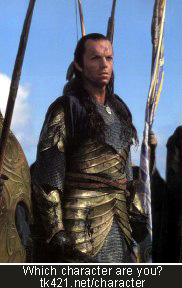 The New Yorker
The New Yorker is not a magazine that is normally thought of as a champion of the views of religious conservatives. Back in October 23, 2006, it published Adam Gopnick's "Reviewing Nature," an article about Darwin's
The Origin of Species, in which Mr. Gopnick, a professed atheist, exuberantly rejected any notion that one might reconcile Darwinian evolutionary theory with the Biblical creation account. No matter to him that Nobel Laureate Francis Crick is only one of many religious scientists who have no problem doing exactly that. Who are you going to believe on matters of science, Professor Francis Crick, the Nobel Prize winning molecular biologist, or Adam Gopnick, the atheist writer?
More recently,
The New Yorker has featured the semi-auto-biographical and undeniably humorous writings of Shalom Auslander, whose recently published memoir,
Foreskin's Lament, is described by
one reviewer as revealing "Auslander's youth in a strict, socially isolated Orthodox [Jewish] community," namely Monsey, New York. A chapter of the same book deals with the brief residency of Shalom and his wife Orli in Teaneck, New Jersey.
Folks, trust me, neither Monsey, nor Teaneck, is socially isolated. The Monsey Jewish community in which Auslander was raised, and Teaneck as well, are hardly isolationist Hasidic in nature. Rather, they are what is commonly referred to as "Modern Orthodox" or "Centrist Orthodox" communities, partaking of a religious philosophy that is very much involved in the secular world, while also very much remaining loyal to Jewish law and observance. [In the spirit of full disclosure, the Kosher Hedgehog is Modern Orthodox.] For example, Auslander's uncle, the brother of his mother, is Rabbi Dr. Norman Lamm, the Chancellor and former President of
Yeshiva University. A prototypical Rabbi of Monsey is Rav Moshe Tendler, PhD, who at Yeshiva University holds the positions of
Rosh Yeshiva (in secular terms, a Dean of Talmudic Studies) and Professor of Biology. These are not quite the primitive troglodytes who Auslander would have us believe are the sole inhabitants of Monsey and Teaneck.
So, as I was saying, when a religious conservative is looking for journalistic vindication of his point of view, he does not normally expect to find it in
The New Yorker.Therefore, I was quite pleasantly surprised to read in the October 15, 2007 issue
an article by Jerome Groopman, entitled "Silent Minds--What Scanning Techniques Are Revealing About Vegetative Patients." The article describes the research conducted over the past decade by Adrian Owen, a British neuroscientist. Conducting brain scans of vegetative patients, he discovered that many showed
normal patterns of brain activity in response to external stimuli, such as speech, photographs and music. His subsequent research suggested that some vegetative patients not only reacted to speech, but comprehended it, and could even perform a complex mental task on command. Conventional medical science had assumed for decades that these types of patients lacked any capacity for conscious thought.
Inspired by the finds of Owen and other researchers, neurosurgeons are now experimenting, with some cases of stunning success, with therapies involving deep brain stimulation of vegetative patients. One of those patients, Terry Wallis, had spontaneously recovered speech to a limited degree after almost 20 years in a vegetative state, has recovered speech. With further medical therapy, he has shown marked improvement. Nicholas Schiff, a Weill Cornell Medical College neurosurgeon, and one of the physicians who is treating Wallis, says "After 19 years, Terry spoke a few words, but within seventy-two hours he recovered fluent, expressive, and receptive language."
Which brings us back to the Terri Schiavo case. As the readers will recall, Ms. Schiavo died from thirst and starvation, at the order of her husband, despite the claims of her parents and caretakers that Ms. Schiavo reacted to their touch and voices. Her husband and his many vocal advocates argued that Ms. Schiavo had no "quality of life," and that she, on the rather skimpy evidence of one brief conversation with her husband, would not want to have had her life prolonged in a vegetative state. The supporters of preserving her life were roundly vilified as religious extremists.
We will never know what a brain scan examination by a scientist such as Dr. Owen would have revealed about Terri Schiavo Perhaps, as a brief discussion of her case in
The New Yorker article concludes, her brain indeed was too damaged to exhibit the responses he found in other vegetative patients. Perhaps not.
Yet, one's conscience ought to be haunted by the words of Kate Bainbridge, the first vegetative patient that Adrian Owen studied in Cambridge. She has recovered the use of her arms and much of her mental function. She is still unable to walk, and has difficulty speaking, using a letter board to communicate with people not used to her speech. But she writes eloquently. In an e-mail to Jerome Goopman, she wrote:
"Most scans show what is wrong with your brain, which the doctors need to know, but Adrian Owen's scans show what is working. I say they found parts of my brain were working. It really scares me to think what might have happened to me if I had not had the scans. They show people it was worth carrying on even though my body was unresponsive."
When I read Ms. Bainbridge's words, I felt rather good about being a religious conservative troglodyte who opposed starving Terri Schiavo to death.



































